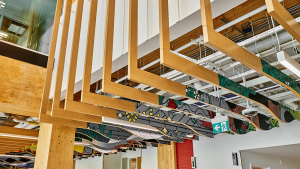Visual monitoring of construction productivity has been one of the primary functions of jobsite cameras for several years. However, recent racially motivated incidents involving nooses on worksites have drawn attention to the need for improved site security and surveillance.
While the hardware is essentially the same for each purpose — solar-powered, wireless cameras that capture real-time, date-stamped imagery — camera location must differ.
“With productivity monitoring, you want to see the entire site and each elevation of the build with a focus on progress, accuracy and avoidance of rework,” says Sensera Systems, a designer and manufacturer of site cameras and software. “For security, the focus would be reversed, with optimal coverage on entry/exit, materials and equipment and other areas of interest around the site perimeter.”
For contractors and project owners, the benefits of onsite cameras are well established. Today’s cameras are wirelessly connected to the Internet, allowing managers to monitor productivity at multiple sites from almost any location. This can reduce rework, aid documentation and assess safety risks across the project site. Cameras are now less expensive, meaning more can be deployed.
Sensera also points out that video monitoring provides visual documentation that supports both contractor and subcontractors. Video can simplify the resolution of any defect claims by showing who did each part of the job, whether the job was done correctly, and when the work was completed.
For the same reason, insurers are beginning to value the contribution that video monitoring can offer beyond providing site safety assessments.
“Having visual documentation can help avoid having multiple subcontractors looped into a claims process that is not relevant to them,” says Sensera.
Reducing material theft and controlling unauthorized site access is another long-standing benefit of video monitoring that insurers appreciate.
However, the continual appearance of nooses on construction jobsites across North America is a specific concern needing urgent attention.
Eight nooses have been found this spring at the construction site of a $250 million Amazon distribution centre in Windsor, Conn., causing Amazon to twice temporarily close the site.
The Amazon project site is sprawling, covering 3.6 million square feet. Hundreds of trades are working simultaneously. Nevertheless, in cases like this, more cameras installed across sites would help cut the number of suspects down considerably and even identify those actually responsible by answering the obvious questions: Who was on site? Who had access to that area?
The racially-motivated events in Connecticut have been embarrassing to Amazon, forcing them to go public by announcing a review of their contractor’s performance.
“We are assessing the performance and management of our developer and general contractor to ensure they are maintaining the standards expected of an Amazon project,” said Kelly Nantel, director of national media relations for Amazon, in a media statement. “We will make any appropriate changes to this project, including re-evaluating our partnerships, to ensure these high standards.”
That statement is damaging to the image of Amazon’s general contractor, RC Andersen. Initially silent, RC Andersen has since announced it will work with both Amazon and local police to identify the perpetrators. RC Andersen’s slow reaction should be a warning to all contractors to be more responsive when such incidents occur.
Amazon’s nooses are not isolated. There have been almost two dozen incidents reported this past year across North America, including high profile occurrences in Canada. Noose episodes, female strippers performing on worksites and the alleged condoning of cat-calling women near jobsites are disturbing, and counter to the construction industry’s drive to be more inclusive.
Following similar noose incidents in Canada, Geoff Smith, president and CEO of EllisDon, issued a statement calling the perpetrators “weak and cowardly.” Joseph Kirk, president of Govan Brown and Associates Limited, reiterated that his company, “boldly stands behind inclusion and diversity, values that are woven into the fabric of our organization.”More cameras strategically placed across sites are worth the cost in terms of enhanced safety, security and company reputation.
John Bleasby is a Coldwater, Ont.-based freelance writer. Send comments and Inside Innovation column ideas to editor@dailycommercialnews.com.










Recent Comments
comments for this post are closed